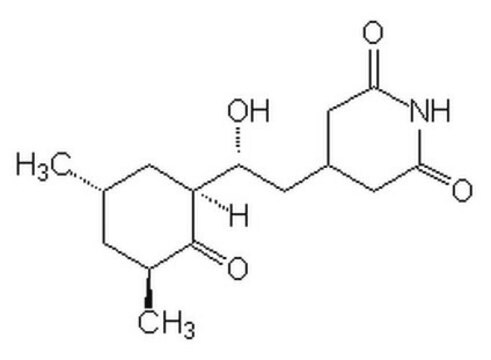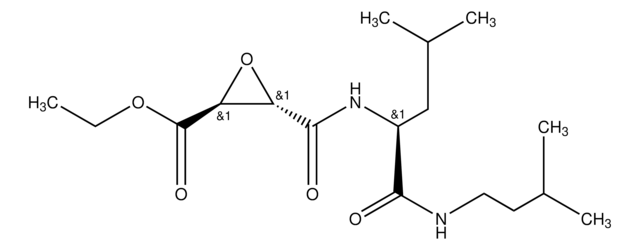239764
Cycloheximide, High Purity
Antifungal antibiotic that inhibits protein synthesis in eukaryotes but not in prokaryotes.
Synonym(s):
Cycloheximide, High Purity
About This Item
Recommended Products
Quality Level
Assay
≥98% (HPLC)
form
solid
potency
3.4 μM Ki
manufacturer/tradename
Calbiochem®
storage condition
OK to freeze
color
white
solubility
chloroform: soluble
ethanol: soluble
methanol: soluble
shipped in
ambient
storage temp.
10-30°C
InChI
1S/C15H23NO4/c1-8-3-9(2)15(20)11(4-8)12(17)5-10-6-13(18)16-14(19)7-10/h8-12,17H,3-7H2,1-2H3,(H,16,18,19)/t8-,9-,11-,12+/m0/s1
InChI key
YPHMISFOHDHNIV-FSZOTQKASA-N
General description
Biochem/physiol Actions
hFKBP12
Warning
Reconstitution
Other Notes
Lu, Q., et al. 1996. Arch. Biochem. Biophys.334, 175.
Chow, S.C., et al. 1995. Exp. Cell Res.216, 149.
Cotter, T.G., et al. 1992. Anticancer Res.12, 773.
Takano, Y.S., et al. 1991. J. Pathol.163, 329.
Waring, P. 1990. J. Biol. Chem. 265, 14476.
Legal Information
Signal Word
Danger
Hazard Statements
Precautionary Statements
Hazard Classifications
Acute Tox. 2 Oral - Aquatic Chronic 2 - Muta. 2 - Repr. 1B
Storage Class Code
6.1A - Combustible acute toxic Cat. 1 and 2 / very toxic hazardous materials
WGK
WGK 3
Flash Point(F)
Not applicable
Flash Point(C)
Not applicable
Regulatory Listings
Regulatory Listings are mainly provided for chemical products. Only limited information can be provided here for non-chemical products. No entry means none of the components are listed. It is the user’s obligation to ensure the safe and legal use of the product.
EU REACH Annex XVII (Restriction List)
Certificates of Analysis (COA)
Search for Certificates of Analysis (COA) by entering the products Lot/Batch Number. Lot and Batch Numbers can be found on a product’s label following the words ‘Lot’ or ‘Batch’.
Already Own This Product?
Find documentation for the products that you have recently purchased in the Document Library.
Customers Also Viewed
Our team of scientists has experience in all areas of research including Life Science, Material Science, Chemical Synthesis, Chromatography, Analytical and many others.
Contact Technical Service







